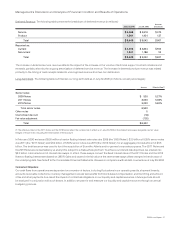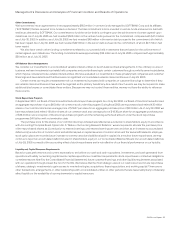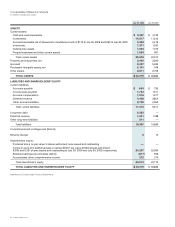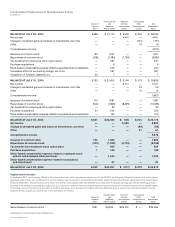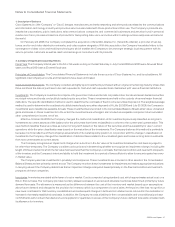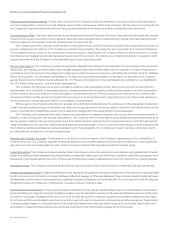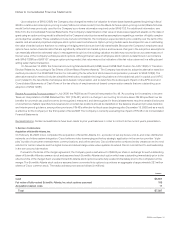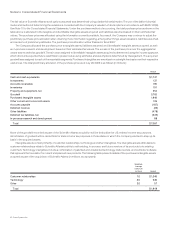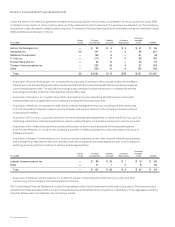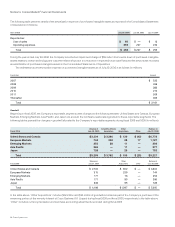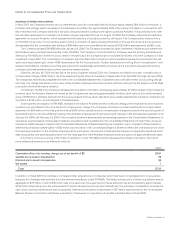Cisco 2006 Annual Report Download - page 44
Download and view the complete annual report
Please find page 44 of the 2006 Cisco annual report below. You can navigate through the pages in the report by either clicking on the pages listed below, or by using the keyword search tool below to find specific information within the annual report.
2006 Annual Report 47
1. Description of Business
Cisco Systems, Inc. (the “Company” or “Cisco”) designs, manufactures, and sells networking and other products related to the communications
and information technology industry and provides services associated with these products and their use. The Company’s products are
installed at corporations, public institutions, telecommunications companies, and commercial businesses and are also found in personal
residences. Cisco provides a broad line of products for transporting data, voice, and video within buildings, across campuses, and around
the world.
On February 24, 2006, the Company completed the acquisition of Scientic-Atlanta, Inc. (“Scientic-Atlanta”), a provider of set-top
boxes, end-to-end video distribution networks, and video system integration. With this acquisition, the Company has added video to the
convergence of data, voice, and mobility technologies, which enables the Company to be a stronger strategic business partner with its
service provider customers, as well as reach a broad range of consumers with its products.
2. Summary of Significant Accounting Policies
Fiscal Year The Company’s scal year is the 52 or 53 weeks ending on the last Saturday in July. Fiscal 2006 and 2005 were 52-week scal
years, and scal 2004 was a 53-week scal year.
Principles of Consolidation The Consolidated Financial Statements include the accounts of Cisco Systems, Inc. and its subsidiaries. All
signicant intercompany accounts and transactions have been eliminated.
Cash and Cash Equivalents The Company considers all highly liquid investments purchased with an original or remaining maturity of less than
three months at the date of purchase to be cash equivalents. Cash and cash equivalents are maintained with various nancial institutions.
Investments The Company’s investments comprise U.S. government notes and bonds; corporate notes, bonds, and asset-backed securities;
municipal notes and bonds; and publicly traded equity securities. These investments are held in the custody of several major nancial
institutions. The specic identication method is used to determine the cost basis of xed income securities disposed of. The weighted-average
method is used to determine the cost basis of publicly traded equity securities disposed of. At July 29, 2006 and July 30, 2005, the Company’s
investments were classied as available-for-sale. These investments are recorded in the Consolidated Balance Sheets at fair value. Unrealized
gains and losses on these investments, to the extent the investments are unhedged, are included as a separate component of accumulated
other comprehensive income, net of tax.
Effective October 29, 2005 the Company changed the method of classication of its investments previously classied as long-term
investments to current assets and the balances for the prior years have been reclassied to conform to the current year’s presentation. This
new method classies these securities as current or long-term based on the nature of the securities and the availability for use in current
operations while the prior classication was based on the maturities of the investments. The Company believes this method is preferable
because it is more reective of the Company’s assessment of its overall liquidity position. In conjunction with this change in classication of
investments, the Company changed the classication of deferred taxes related to the unrealized gains and losses on long-term investments
from noncurrent assets to current assets.
The Company recognizes an impairment charge when a decline in the fair value of its investments below the cost basis is judged to
be other-than-temporary. The Company considers various factors in determining whether to recognize an impairment charge, including the
length of time and extent to which the fair value has been less than the Company’s cost basis, the nancial condition and near-term prospects
of the investee, and the Company’s intent and ability to hold the investment for a period of time sufcient to allow for any anticipated recovery
in market value.
The Company also has investments in privately held companies. These investments are included in other assets in the Consolidated
Balance Sheets and are primarily carried at cost. The Company monitors these investments for impairment and makes appropriate reductions
in carrying values if the Company determines that an impairment charge is required based primarily on the nancial condition and near-term
prospects of these companies.
Inventories Inventories are stated at the lower of cost or market. Cost is computed using standard cost, which approximates actual cost, on a
rst-in, rst-out basis. The Company provides inventory allowances based on excess and obsolete inventories determined primarily by future
demand forecasts. The allowance is measured as the difference between the cost of the inventory and market based upon assumptions
about future demand and charged to the provision for inventory, which is a component of cost of sales. At the point of the loss recognition, a
new, lower-cost basis for that inventory is established, and subsequent changes in facts and circumstances do not result in the restoration or
increase in that newly established cost basis. In addition, the Company records a liability for rm, noncancelable, and unconditional purchase
commitments with contract manufacturers and suppliers for quantities in excess of the Company’s future demand forecasts consistent with
its allowance for inventory.
Notes to Consolidated Financial Statements


